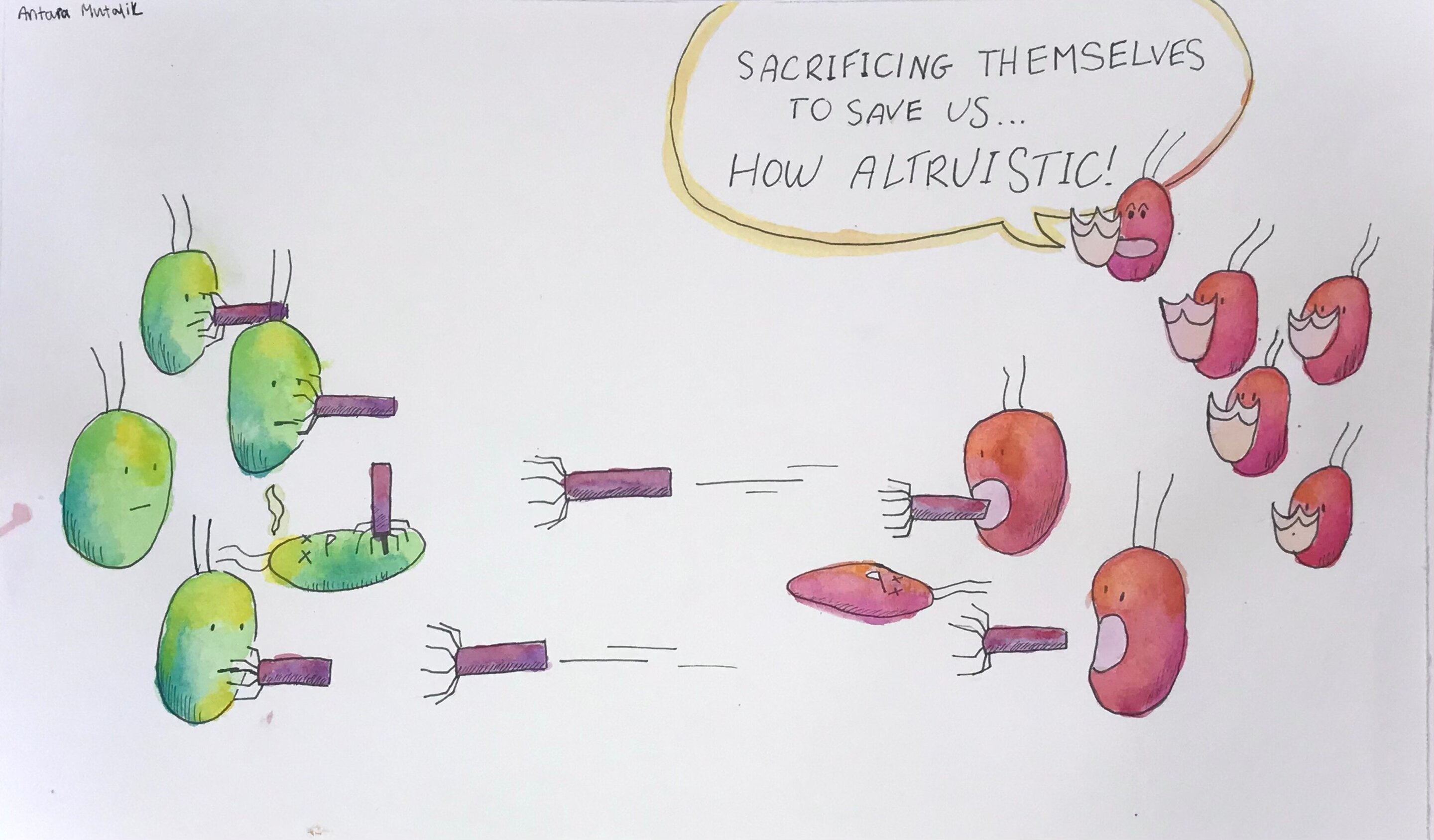
An illustration of tailocins, and their altruistic action painted by the author Vivek Mutalik’s daughter, Antara. Credit: Antara Mutalik
Imagine there are arrows that are deadly when fired at your enemies, yet harmless when dropped on your friends. It’s easy to see how it would be a great advantage in warfare if it were real. However, something like these arrows does exist, and it is used in warfare … only on a different scale.
These weapons are called tailocins, and reality is almost stranger than fiction.
“Tailocins are extremely powerful protein nanomachines produced by bacteria,” explained Vivek Mutalik, a research scientist at Lawrence Berkeley National Laboratory (Berkeley Lab), who studies tailocins and phage, explaining the bacterial-infecting viruses that tailocins look like are remnants. “They look like phages, but they do not have the capsid, it is the ‘head’ of the phage that contains the viral DNA and replication machinery. So it is like a feather-driven needle that sits on the target cell, then it looks like as if it were piercing the cell membrane and making a hole in the cytoplasm so that the cell loses its ions and contents and collapses. ‘
A large variety of bacteria can produce tailocins, and they appear to do so under stress conditions. Because the tailocins are only lethal to specific strains – so specific that they have earned the nickname “bacterial homing missiles”, it appears that tailocins are a tool used by bacteria to compete with their competitors. Because of their similarity to phage, scientists believe that the tailocins are produced by DNA that was originally inserted into bacterial genomes during viral infections (viruses instruct their hosts to make more of themselves), and over evolutionary time the bacteria have the parts of the phage DNA that was not beneficial but retained the parts that could be co-opted for their own benefit.
But unlike most abilities selected by evolution, tailocins do not save the individual. According to Mutalik, bacteria are killed when they produce tailocins, just like when they are infected by true phage virus, because the pointed nanomachines burst through the membrane to leave the producing cell, just like repeated viral particles. But once the tailocins are released, they are only targeted at certain strains, saving the other cells of the host line.
“They benefit family members, but the individual is sacrificed, which is a kind of altruistic behavior. But we still do not understand how this phenomenon happens in nature,” Mutalik said. Scientists also do not know exactly how the needle of the tailocin works.
These topics, and tailocins as a whole, are a research area because of the many possible applications. Mutalik and his colleagues at Berkeley Lab’s Biosciences Area, along with collaborators from UC Berkeley, would like to use tailocins to better study microbiomes. Other groups would like to use tailocins as an alternative to traditional antibiotics, which indiscriminately eradicate beneficial strains along the bad and are increasingly ineffective due to the development of drug resistance properties.
In their most recent article, the collaborative Berkeley team examined the genetic basis and physical mechanisms that determine how tailocins attack specific strains, and looked at genetic similarities and differences between tailocin producers and their target strains.
After examining 12 strains of soil bacteria known to use tailocins, biologists found evidence that the differences in the lipopolysaccharides – fat and sugar molecules – attached to the outer membranes could determine whether a strain by a particular tailocin is targeted.
“The bacteria we studied live in a challenging, resource-poor environment, so we’re interested in seeing how they can use tailocins to fight for survival,” said Adam Arkin, co-author and senior scientist in the Biosciences, said. Area and technical co-manager of the scientific focus area of the ecosystems and networks integrated with genes and molecular compositions (ENIGMA). Arkin noted that while scientists can easily cause bacteria to produce tailocins in the laboratory (and easily place the genes in culturable strains for mass production, which would come in handy if we want to make tailocins in medicine), there are still many unanswered questions. . about how bacteria tailocins deploy in their natural environment, as well as how and why specific strains are targeted with an assassin’s precision.
“Once we understand the targeting mechanisms, we can start using these tailocins ourselves,” Arkin added. “The potential for medicine is huge, of course, but it will also be incredible for the kind of science we do, which studies how environmental microbes interact and the roles of these interactions in important ecological processes, such as carbon sequestration and nitrogen processing.”
Currently, it is very difficult to figure out what each microbe does in a community, as scientists cannot easily pick up and subtract strains and observe the outcome. With properly utilized tailocins, these experiments can be easily done.
Mutalik, Arkin and their colleagues are also conducting follow-up studies aimed at revealing the mechanisms of action of tailocins. They plan to use the advanced imaging facilities at Berkeley Lab to take snapshots at the atomic level of the entire process, from the moment the tailocin binds to the target cell to the cell deflation. In essence, they will be filming frames of a microscopic slasher film.
Catalog of nature’s hidden arsenal: viruses that infect bacteria
Sean Carim et al., Systematic discovery of pseudomonadic genetic factors involved in sensitivity to tailocins, The ISME Journal (2021). DOI: 10.1038 / s41396-021-00921-1
Provided by Lawrence Berkeley National Laboratory
Quotation: The incredible bacterial ‘homing missiles’ that scientists want to deploy (2021, April 7), were detected on April 7, 2021 from https://phys.org/news/2021-04-incredible-bacterial-homing-missiles-scientists. html
This document is subject to copyright. Except for any fair trade for the purpose of private study or research, no portion may be reproduced without the written permission. The content is provided for informational purposes only.
